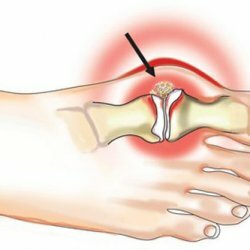Etiological and pathogenetic treatment of rheumatism

Etiologic treatment of rheumatism
Etiological treatment is the elimination of foci of streptococcal infection. The most frequent and especially important in the development of rheumatism and its complications, the focus of infection of hemolytic streptococcus group A is chronic tonsillitis. Therefore, the sanation of this focus is of paramount importance in the fight against rheumatism. Other foci of chronic infection, such as caries and chronic periodontitis, pyelonephritis, cholecystitis, chronic sinusitis, are usually caused by other pathogens. But the presence of such chronic sluggish inflammation in the body causes a violation of immunological activity, which in turn under certain conditions provokes an aggravation of rheumatism.
Despite the fact that modern medicine, there is a huge arsenal of antibacterial drugs( antibiotics), hemolytic streptococcus is naturally sensitive to penicillin, so until now, this antibiotic is the main in the treatment of rheumatic infection( drug of choice).
Penicillin
Penicillin produced during the life of mold fungus Penicillium, by its chemical composition, it is an acid, from which subsequently obtained salt -. Potassium, sodium, etc.
By semisynthetic penicillins( e.g., ampicillin, oxacillin) were obtained with the development of pharmaceutical sciences, Having a broader spectrum of action, that is, affecting a greater number of species of microorganisms.
Preparations of the penicillin group of antibiotics on the rate of onset of antimicrobial action, its duration, time and methods of excretion from the body, as well as the ability to accumulate in organs or tissues( tropism to a particular tissue).
Benzylpenicillin sodium salt
Benzyl penicillin sodium salt is injected intramuscularly 4-6 times a day for a minimum of ten days. This frequency of antibiotic administration is due to the fact that in 30-40 minutes after intramuscular injection the maximum concentration of the drug is reached in the patient's blood, and already in 3-4 hours it drops almost to zero. The daily dose of penicillin is 300-500 thousand units per kilogram of body weight.
can also recommend sparing regimen: the first 5-7 days of illness penicillin administered intramuscularly in the dosages specified above, and after decrease of acute clinical symptoms administered intramuscularly once penicillin depot - bicillin 1: preschool children in the dose 600 thousand IU,.schoolchildren and adults - 1,200 thousand units, or bitsillin-5( a mixture of one part of benzylpenicillin procaine salt - 300 thousand units and 4 parts bitsillina-1 - 1,200 thousand units...): preschool children in the dose 750 thousand IU, schoolchildren and. Adults - 1500 youWith the ED.
In case of intolerance to penicillin drugs, other antibiotics are prescribed: erythromycin, oleandomycin, oxacillin.
Erythromycin Erythromycin is prescribed in the following dosages: preschool children 30 mg per kilogram of body weight, the students of 40 mg per kilogram body weight for adults - 150-200 thousand units per day..
Oleandomycin
Daily doses of oleandomycin: for children from three to six years - 0.25-0.5 g, from six to fourteen years - 0.5-1.0 g, for adults - 2000 thousand units.
Oxacillin
Oxacillin is prescribed at the rate of 200-500 thousand units per kilogram of body weight per day, dividing the daily dose into 4-6 receptions.
When administering antibiotics orally( through the mouth), it is important to take them regularly to maintain a consistent therapeutic concentration of the antibiotic in the blood.
treatment of streptococcal infections with antibiotics tetracycline and sulfanilamide drugs currently considered inappropriate because it revealed a rapid "addictive" hemolytic streptococcus group A to this group of drugs - decreased sensitivity to their impacts.
Pathogenetic treatment of rheumatism
Pathogenetic treatment of rheumatism is the treatment of those inflammatory and immunopathological processes that arise in the patient's body in response to the introduction of an infectious agent. Accordingly, it is carried out anti-inflammatory drugs that have immunocorrecting properties. In the first place, these requirements are met by hormones of the adrenal cortex - glucocorticoids( synonyms: corticosteroids, steroids, steroid hormones).This is the only group of drugs that combine pronounced anti-inflammatory and immunosuppressive properties. That is why they occupy a leading place in the therapy of rheumatoid diseases, including rheumatism.
Hormones of adrenal cortex
Adrenal cortex hormones began to be used as medications in the middle of the 20th century, and this was a huge step forward in the development of rheumatology and in medicine in general. Hormone therapy is used for various allergic diseases, with blood diseases, kidney disease, liver disease, bronchial asthma, and cancer therapy. The role of glucocorticoids in the treatment of shock conditions of various origins, the treatment of infectious diseases is invaluable;They are the main therapeutic means for organ transplantation.
The best and most widely used drug in this group is prednisolone, which is well tolerated and has a strong and pronounced curative effect. Prednisolone is easily absorbed in the gastrointestinal tract, already within 1-2 hours after intake, its maximum concentration in the blood is reached. Prednisolone is neutralized in the liver, and the products of disintegration are excreted in the urine.
For the treatment of active rheumatism prednisolone is prescribed in almost all forms of the disease, although the results of treatment are different. The therapeutic effect of corticosteroids is most pronounced in primary rheumatic heart disease;At 3 degrees of activity of rheumatism, than at 1 degree of activity. Prolonged and continuously progressive forms of rheumatism almost can not be cured by glucocorticoids. Therefore, the inefficiency of steroids in acute and subacute forms of rheumatism is a serious indication of the likelihood of a chronic course of the disease.
A good therapeutic effect of corticosteroids was noted for all manifestations and localizations of rheumatism, including rheumatic chorea. Very well give in to hormonal therapy of heart disease. It is believed that timely and correctly prescribed therapy with corticosteroids prevents the development of heart defects.
Usually, when rheumatism is prescribed, average doses of prednisolone 25-20 mg per day, when the therapeutic effect is achieved, the dose is gradually reduced by 2.5 mg every 5-7 days. The course of treatment lasts 1-2 months.
Non-steroidal anti-inflammatory drugs
The next group of drugs used in the therapy of rheumatism are non-steroidal anti-inflammatory drugs. The oldest in this group of drugs is salicylates.
Salicylates
Salicylates are well absorbed into the bloodstream through the gastrointestinal tract, then quickly distributed in the body, falling mainly into the synovial fluid of the articular membranes, myocardium, lungs, kidneys and liver. The maximum concentration of salicylates in the blood plasma is kept for 2 hours after admission, and they are excreted through the kidneys almost completely after 48 hours.
Acetylsalicylic acid is used in doses of 50-70 mn per kilogram of body weight per day in the acute phase of the disease( 3-4 grams per day), 25-35 mg per kilogram of body weight per day as a maintenance dose( 1.5-2 gper day).Children dose is selected at the rate of 0.2 g per year of life. The duration of taking aspirin is 1.5-2 months.
Contraindications for the appointment of salicylates:
- peptic ulcer of the stomach and duodenum;
- information on gastrointestinal bleeding in the past;
- bleeding disorders, increased bleeding;
- pregnancy, especially on long terms.
Stay healthy!



